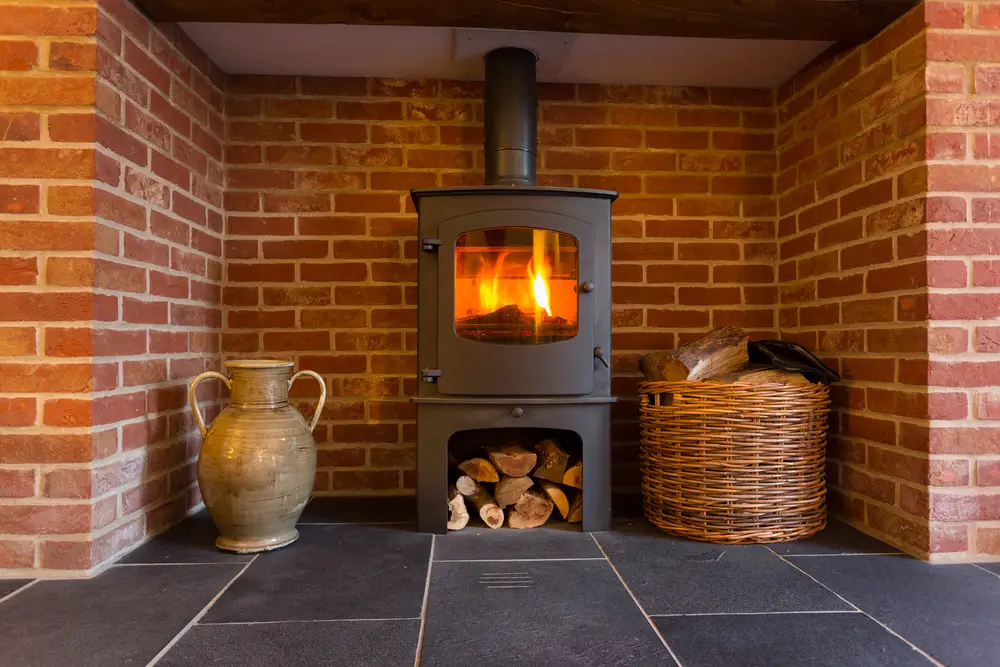Discover the intriguing world of hybrid wood stoves, unlocking the combination of traditional charm and modern efficiency.
A hybrid wood stove combines two distinct burn systems namely burn tubes and a catalytic combustor system. While burn tubes deliver secondary combustion at around 1100°F, a catalytic combustor does that at 500°F. A hybrid wood stove can achieve a thermal efficiency of 80% or more.
In this post, I will explain how hybrid wood stoves work and why environmentally conscious homeowners are showing interest in them. Read on to find out more about answers to some of your nagging questions regarding these heating appliances.

How does a hybrid wood stove work?
A hybrid wood stove combines two distinct combustion systems: a catalytic combustor and burn tubes. The combination of the two technologies make the stove highly efficient.
A catalytic wood-burning stove contains a honeycomb-shaped catalytic combustor designed to burn smoke and other pollutants created by the combustion—a process known as secondary combustion, which results in more efficiency. Naturally, secondary combustion naturally takes place at around 1100°F, but a catalytic combustor can cause it at around 500°F.
A non-catalytic wood stove has no catalytic combustor, and therefore does not deliver secondary combustion unless the temperature has reached 1100°F. However, modern non-catalytic wood-burning stoves contain a secondary combustion chamber or air tubes that re-burn the flue gasses and thus increase efficiency.
A hybrid wood-burning stove has both air tubes and a catalytic combustor. The baffle technology performs secondary combustion while the catalytic combustor provides tertiary combustion. Thanks to the high efficiency of a hybrid stove, the chimney emits very little smoke.
Are hybrid wood stoves environmentally friendly?
A hybrid wood stove contains two distinct systems for burning flue gasses. The combustion occurs in three phases, resulting in high efficiency. These stoves are characterized by ultra-low emissions.
The first stage is the combustion of the wood and the second stage is the re-ignition of the gasses produced by the combustion. Then, as the remaining gasses come in contact with the catalytic combustor, the tertiary combustion takes place.
In a conventional wood-burning stove, secondary combustion takes place only when the heat output is really high. What makes a hybrid stove different is that it achieves a high level of efficiency even when the heat output is relatively low.
A catalytic combustor can increase the efficiency of the stove by 10%, reduce creosote production by 20-90%, and decrease air pollution by up to 75%. We have to remember that this level of efficiency can be achieved by a wood stove with a catalytic combustor—not necessarily a hybrid unit.
Hybrid wood-burning stoves are often referred to as the gold standard of efficient wood stoves because they combine two distinct means of reducing emissions. As the gasses and particulates are burned for the third time, little to not energy is wasted.

How do the secondary air tubes work in a wood stove?
Secondary air tubes, also known as secondary burn tubes, are a set of tubes with holes in them. Located at the top of the firebox, these tubes get super hot during the combustion process. The system involves feeding additional air to the tubes.
As the smoke and particulates generated by the primary combustion meet the oxygen coming out of the tube holes, the temperature there becomes high enough to re-burn the smoke and particulates. This procedure prevents the smoke and gasses from getting out through the flue pipe and turns them into energy instead.
It is to be noted here that most of the heat generated by a modern wood-burning stove is from this secondary combustion, not the primary burning of the fuel logs. Unlike the catalytic combustor, the secondary air tubes are automatic. You do not have to engage them manually. The tubes do not require regular maintenance.
How does a catalytic combustor work?
A catalytic combustor resembles a honeycomb and can be rectangular, circular or oval in shape. Usually, the device is coated with a noble metal called palladium, which withstands high temperatures. The combustion of wood gives off smoke and gasses that are not re-burned until the temperature of the stove has reached 1100°F.
Acting as a catalyst, the combustor re-burns the gasses at around 500°F. While this component starts working at 350ºF, its performance is remarkable when the temperature is at least 500ºF.
Instead of making their way out through the chimney, the smoke and gasses are re-burned to generate more heat. The combustor allows you to get the best out of your stove even when the fire is burning slowly.
In a hybrid wood stove, the baffle technology works by default, but you have to manually engage the combustor. For this, you have to monitor the stove temperature to know if it has reached 500°F. A modern hybrid stove comes with a thermometer that shows the stove temperature.
How much maintenance does the catalytic combustor require?
While a catalytic combustor typically lasts 12,000-14,000 hours of use, to some extent its durability and performance depends on the way it is used and maintained. Here are some tips that will help you get the best out of the combustor:
- Moisture in the firewood reduces the efficiency of the combustor by cooling it down, so burn only dry wood with a moisture content of less than 20%. Burning wet wood can even lead to carbon monoxide poisoning.
- Do not engage the combustor until the firebox has reached 500°F, the temperature at which the device effectively begins to re-burn the smoke and gasses.
- When you reload the firebox for a short period while the steam evaporates and the stove returns to 500°F.
- Excessive heat reduces the combustor’s effectiveness, so try to avoid over firing your stove.
- Use a soft bristled brush or vacuum cleaner to clean the combustor every couple of months.
How to know when your hybrid wood stove needs a new catalytic combustor
If the catalytic combustor has obvious problems, you can identify them just by looking at the combustor. However, a visual inspection may not be enough because a combustor may not work properly even if it looks flawless.
Decreased heat output is the most obvious sign that you need to replace your catalytic combustor with a new one. In general, the heat output goes down after the combustor has served for over 12,000 hours.
Heat output, however, may be affected by factors such as draft conditions and the quality of firewood. Look at the thermometer to tell if the combustor is reaching the temperature it used to.
The accumulation of excessive condensation or creosote can indicate that the combustor is performing poorly. Look at the chimney walls. If there is excessive creosote, a poorly functional catalytic combustor may be responsible for it.
If the stove does not draw sufficiently when you engage the combustor, it may be due to the sluggish performance of the combustor.
One of the main purposes of the catalytic combustor is to reduce the emission of smoke. So, if you notice plenty of smoke even when you keep the combustor engaged, it is probably not operating properly. Black smoke is another indicator that the combustor needs to be replaced.

Conclusion
A hybrid wood-burning stove is highly efficient because it employs both air tubes and a catalytic combustor for secondary and tertiary combustion respectively. Such a unit is characterised by long burn times, efficient fires, and little to no emissions.
While the triple burn system remarkably increases efficiency and lowers emissions, the efficiency of the unit still largely depends on the way it is used and maintained. Whether you are using a catalytic, non-catalytic or hybrid stove, be sure to burn only sufficiently seasoned wood, and ensure regular maintenance of the stove.
